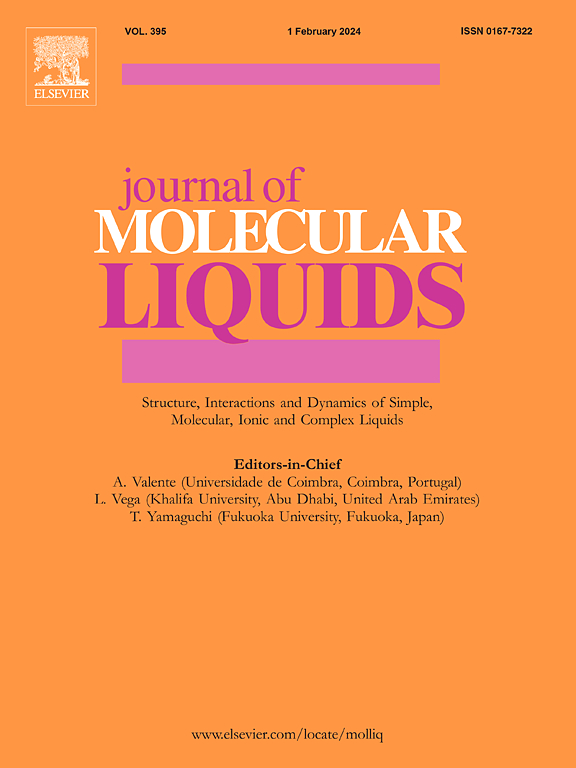吡啶基定向离子液体的合成、表征及其在0.05M HCl中6061Al-10(vol%) SiC(p)复合材料缓蚀中的应用
IF 5.3
2区 化学
Q2 CHEMISTRY, PHYSICAL
引用次数: 0
摘要
本文合成了一种新型离子液体4,4′-(肼-1,2-二乙基吡啶双(甲基乙基))-二(1-(2,3-二羟丙基)吡啶-1-ium -氯(HMP),并对其进行了综合表征。在0.05M HCl溶液中,考察了HMP作为6061Al-10 vol% SiC金属基复合材料(6061Al-CM)缓蚀剂的电化学性能。电化学测试表明,HMP在303 K时的最大缓蚀率为94%。该化合物为混合型缓蚀剂,以物理吸附为主,服从Langmuir吸附等温线。利用扫描电子显微镜(SEM)、能量色散x射线能谱(EDS)和原子力显微镜(AFM)对复合材料表面进行形貌分析,证实复合材料表面形成了保护抑制剂膜。此外,基于密度泛函理论(DFT)的量子化学计算为HMP的电子性质及其在金属表面的吸附行为提供了见解。本文章由计算机程序翻译,如有差异,请以英文原文为准。

Synthesis and characterization of pyridinium-based dicationic ionic liquid and its application in corrosion mitigation of 6061Al-10(vol%) SiC(p) composite in 0.05M HCl
In the present investigation, a novel ionic liquid, 4,4′-(hydrazine-1,2-diylidenebis(methanylylidene))bis(1-(2,3-dihydroxypropyl)pyridin-1-ium) chloride (HMP), was synthesized and comprehensively characterized. The electrochemical performance of HMP as a corrosion inhibitor for 6061Al–10 vol% SiC metal matrix composite (6061Al-CM) was evaluated in 0.05M HCl solution. Electrochemical measurements revealed that HMP exhibited a maximum inhibition efficiency of 94 % at 303 K. The compound functioned as a mixed-type inhibitor, predominantly undergoing physisorption, and obeyed the Langmuir adsorption isotherm. Surface morphological analysis using scanning electron microscopy (SEM), energy-dispersive X-ray spectroscopy (EDS), and atomic force microscopy (AFM) confirmed the formation of a protective inhibitor film on the composite surface. Furthermore, quantum chemical calculations based on density functional theory (DFT) provided insights into the electronic properties of HMP and its adsorption behavior on the metal surface.
求助全文
通过发布文献求助,成功后即可免费获取论文全文。
去求助
来源期刊

Journal of Molecular Liquids
化学-物理:原子、分子和化学物理
CiteScore
10.30
自引率
16.70%
发文量
2597
审稿时长
78 days
期刊介绍:
The journal includes papers in the following areas:
– Simple organic liquids and mixtures
– Ionic liquids
– Surfactant solutions (including micelles and vesicles) and liquid interfaces
– Colloidal solutions and nanoparticles
– Thermotropic and lyotropic liquid crystals
– Ferrofluids
– Water, aqueous solutions and other hydrogen-bonded liquids
– Lubricants, polymer solutions and melts
– Molten metals and salts
– Phase transitions and critical phenomena in liquids and confined fluids
– Self assembly in complex liquids.– Biomolecules in solution
The emphasis is on the molecular (or microscopic) understanding of particular liquids or liquid systems, especially concerning structure, dynamics and intermolecular forces. The experimental techniques used may include:
– Conventional spectroscopy (mid-IR and far-IR, Raman, NMR, etc.)
– Non-linear optics and time resolved spectroscopy (psec, fsec, asec, ISRS, etc.)
– Light scattering (Rayleigh, Brillouin, PCS, etc.)
– Dielectric relaxation
– X-ray and neutron scattering and diffraction.
Experimental studies, computer simulations (MD or MC) and analytical theory will be considered for publication; papers just reporting experimental results that do not contribute to the understanding of the fundamentals of molecular and ionic liquids will not be accepted. Only papers of a non-routine nature and advancing the field will be considered for publication.
 求助内容:
求助内容: 应助结果提醒方式:
应助结果提醒方式:


